Effect of Refining Temperature and Refining Time on Purification and Composition Control of FGH95 Powder Metallurgy Superalloy Return Material During Vacuum Induction Melting
Abstract
1. Introduction
2. Materials and Methods
2.1. Experimental Materials
2.2. Experimental Procedure
2.3. Analysis & Testing
3. Results
3.1. Effect of Refining Time on Purification
3.2. Effect of Refining Temperature on Purification
3.3. Microstructural Characterization
4. Discussion
4.1. Effect of Refining Time on Deoxidation Kinetics
- Initial Reaction-Controlled Stage: During the first few minutes, deoxidation proceeds rapidly due to high O concentration gradients, efficient bubble nucleation, and strong thermodynamic driving force.
- Transition to Diffusion-Controlled Stage: As O content decreases, further removal becomes kinetically limited by the diffusion of O atoms through the melt. At this stage, the rate of gas transport to the surface becomes the limiting factor, explaining the marginal benefit of prolonged refining time.
4.2. Effect of Refining Temperature on Deoxidation Kinetics
- Increased O Activity and Reduced Solubility: According to Sieverts’ law, the solubility of gases in molten metal decreases with increasing temperature under vacuum. Higher temperatures elevate the activity coefficient of O, making it more prone to escape from the melt.
- Enhanced Kinetic Conditions: Elevated temperature reduces melt viscosity and surface tension, facilitating the diffusion and migration of dissolved O to the melt surface where it can be evacuated by the vacuum environment. This promotes bubble nucleation and flotation, accelerating deoxidation kinetics. However, as the temperature approaches 1650 °C, the rate of improvement diminishes. This plateau effect suggests that the system approaches a diffusion-limited regime, where further temperature increases yield marginal benefits while risking the loss of volatile alloying elements (e.g., Al, Ti).
4.3. Mathematical Model of Deoxidation Kinetics
4.4. Elemental Stability During Refining
4.5. Implications for Industrial Recycling
5. Conclusions
- A robust refining process window for recycling FGH95 P/M superalloy machining returns was established at 1600 ± 20 °C for 10 ±3 min under ≤ 1 × 10−2 Pa, achieving stable purification with O ≤ 20 ppm, N ≤ 20 ppm, and H < 10 ppm. A process tolerancing analysis confirmed that minor deviations in temperature and holding time do not compromise gas impurity control.
- The nominal alloy composition and γ/γ′ two-phase microstructure were well preserved after refining. The concentrations of Al, Ti, and Cr remained within specification limits, and microstructural observations confirmed that the primary strengthening γ′ phase retained its morphology and distribution, ensuring mechanical integrity of the recycled alloy.
- A deoxidation kinetics model was developed to describe O removal under vacuum refining. The fitted parameters showed excellent correlation. The model accurately predicts O removal behavior within the studied temperature–time–vacuum range but requires recalibration for different initial O levels, melt sizes, or vacuum degrees.
Author Contributions
Funding
Data Availability Statement
Conflicts of Interest
References
- Hu, B.F.; Chen, H.M.; Song, D.; Li, H.Y. Research on the Carbides in FGH95 Superalloy Powders Prepared by PREP during Solidification. J. Mater. Eng. 2005, 41, 1042–1046. [Google Scholar]
- Gao, Y.; Zou, J.; Wang, X.; Wang, X.; Yang, J.; Wang, H. Microstructure and Mechanical Performance of Graphene Nanosheets Reinforced Nickel-Based Superalloy FGH95 Composite. Nanomaterials 2020, 10, 100. [Google Scholar] [CrossRef]
- Xu, Y.; Ge, C.; Shu, Q. Microstructure, Tensile Properties and Heat Treatment Process of Spray Formed FGH95 Superalloy. J. Iron Steel Res. Int. 2013, 20, 59–63. [Google Scholar] [CrossRef]
- Hu, D.; Wang, R.; Fan, J.; Shen, X. Probabilistic Damage Tolerance Analysis on Turbine Disk through Experimental Data. Eng. Fract. Mech. 2012, 87, 73–82. [Google Scholar] [CrossRef]
- Yin, F.-Z.; Hu, B.-F.; Jin, K.-S.; Jia, C.-C. Effect of Hot Extrusion and Heat Treatment on the Gamma’ Phase Precipitation in FGH 95 Alloy. J. Mater. Eng. 2005, 52–55. [Google Scholar]
- Zhang, Y.; Yang, S.Z.; Li, L. Current Status of Research on PM Superalloy in China. Mater. Rev. 2002, 16, 14. [Google Scholar]
- Bianchi, L.M. Powder Production: Argon Atomized Superalloys for Jet Engine Discs. In Proceedings of the European Congress and Exhibition on Powder Metallurgy, European PM Conference Proceedings, Valencia, Spain, 20–22 October 2003; Volume 3, p. 1. [Google Scholar]
- Lu, Z.Z.; Liu, C.L.; Yue, Z.F.; Xu, Y.L. Probabilistic Safe Analysis of the Working Life of a Powder Metallurgical Turbine Disc. Mater. Sci. Eng. A 2005, 395, 153–159. [Google Scholar] [CrossRef]
- Bhaumik, S.K.; Bhaskaran, T.A.; Rangaraju, R.; Venkataswamy, M.A.; Parameswara, M.A.; Krishnan, R.V. Failure of Turbine Rotor Blisk of an Aircraft Engine. Eng. Fail. Anal. 2002, 9, 287–301. [Google Scholar] [CrossRef]
- Tan, L.; Huang, Z.; Liu, F.; He, G.; Wang, X.; Huang, L.; Zhang, Y.; Jiang, L. Effects of Strain Amount and Strain Rate on Grain Structure of a Novel High Co Nickel-Based Polycrystalline Superalloy. Mater. Des. 2017, 131, 60–68. [Google Scholar] [CrossRef]
- Grison, J.; Remy, L. Fatigue Failure Probability in a Powder Metallurgy Ni-Base Superalloy. Eng. Fract. Mech. 1997, 57, 41–55. [Google Scholar] [CrossRef]
- Semiatin, S.L.; McClary, K.E.; Rollett, A.D.; Roberts, C.G.; Payton, E.J.; Zhang, F.; Gabb, T.P. Microstructure Evolution during Supersolvus Heat Treatment of a Powder Metallurgy Nickel-Base Superalloy. Metall. Mater. Trans. A 2012, 43, 1649–1661. [Google Scholar] [CrossRef]
- Qiu, C.L.; Attallah, M.M.; Wu, X.H.; Andrews, P. Influence of Hot Isostatic Pressing Temperature on Microstructure and Tensile Properties of a Nickel-Based Superalloy Powder. Mater. Sci. Eng. A 2013, 564, 176–185. [Google Scholar] [CrossRef]
- Qiu, C.; Wu, X.; Mei, J.; Andrews, P.; Voice, W. Influence of Heat Treatment on Microstructure and Tensile Behavior of a Hot Isostatically Pressed Nickel-Based Superalloy. J. Alloys Compd. 2013, 578, 454–464. [Google Scholar] [CrossRef]
- Cui, F.; Wang, G.; Yu, D.; Gan, X.; Tian, Q.; Guo, X. Towards “Zero Waste” Extraction of Nickel from Scrap Nickel-Based Superalloy Using Magnesium. J. Clean. Prod. 2020, 262, 121275. [Google Scholar] [CrossRef]
- DeBarbadillo, J.J. Nickel-Base Superalloys; Physical Metallurgy of Recycling. Metall. Trans. A 1983, 14, 329–341. [Google Scholar] [CrossRef]
- Brooks, P.T.; Potter, G.M.; Martin, D.A. Chemical Reclaiming of Superalloy Scrap; US Department of Interior, Bureau of Mines: Washington, DC, USA, 1969; Volume 7316.
- Yagi, R.; Okabe, T.H. Recovery of Nickel from Nickel-Based Superalloy Scraps by Utilizing Molten Zinc. Metall. Mater. Trans. B 2017, 48, 335–345. [Google Scholar] [CrossRef]
- Miller, C.F.; Simmons, G.W.; Wei, R.P. Mechanism for Oxygen Enhanced Crack Growth in Inconel 718. Scr. Mater. 2001, 44, 2405–2410. [Google Scholar] [CrossRef]
- Guo, W.; Wu, J.; Zhang, F.; Zhao, M. Microstructure, Properties and Heat Treatment Process of Powder Metallurgy Superalloy FGH95. J. Iron Steel Res. Int. 2006, 13, 65–68. [Google Scholar] [CrossRef]
- Utada, S.; Joh, Y.; Osawa, M.; Yokokawa, T.; Sugiyama, T.; Kobayashi, T.; Kawagishi, K.; Suzuki, S.; Harada, H. Creep Property and Phase Stability of Sulfur-Doped Ni-Base Single-Crystal Superalloys and Effectiveness of CaO Desulfurization. Metall. Mater. Trans. A 2018, 49, 4029–4041. [Google Scholar] [CrossRef]
- Vilar, R.; Almeida, A. Repair and Manufacturing of Single Crystal Ni-Based Superalloys Components by Laser Powder Deposition—A Review. J. Laser Appl. 2015, 27. [Google Scholar] [CrossRef]
- Zhao, Y.; Zhang, J.; Song, F.; Zhang, M.; Luo, Y.; Zhao, H.; Tang, D. Effect of Trace Boron on Microstructural Evolution and High Temperature Creep Performance in Re-Contianing Single Crystal Superalloys. Prog. Nat. Sci. Mater. Int. 2020, 30, 371–381. [Google Scholar] [CrossRef]
- Long, H.; Mao, S.; Liu, Y.; Zhang, Z.; Han, X. Microstructural and Compositional Design of Ni-Based Single Crystalline Superalloys―A Review. J. Alloys Compd. 2018, 743, 203–220. [Google Scholar] [CrossRef]
- Luo, C.; Yang, X.; Weng, H.; Yuan, H. Degradation Mechanism of Nickel-Base Single Crystal Superalloy after Long-Term Aging: Roles of Nanomechanical Properties and Morphology of γ/Γ′ Phases. J. Mater. Sci. Technol. 2026, 248, 247–265. [Google Scholar] [CrossRef]
- Kangazian, J.; Shamanian, M.; Kermanpur, A.; Foroozmehr, E.; Badrossamay, M. Investigation of Microstructure-Tensile Behavior Relationship in Hastelloy X Ni-Based Superalloy Processed by Laser Powder-Bed Fusion: Insights into the Elevated Temperature Ductility Loss. Mater. Sci. Eng. A 2021, 823, 141742. [Google Scholar] [CrossRef]
- Weng, F.; Liu, Y.; Chew, Y.; Yao, X.; Sui, S.; Tan, C.; Ng, F.L.; Bi, G. IN100 Ni-Based Superalloy Fabricated by Micro-Laser Aided Additive Manufacturing: Correlation of the Microstructure and Fracture Mechanism. Mater. Sci. Eng. A 2020, 788, 139467. [Google Scholar] [CrossRef]
- Xie, X.; Li, J.; Jiang, W.; Dong, Z.; Tu, S.-T.; Zhai, X.; Zhao, X. Nonhomogeneous Microstructure Formation and Its Role on Tensile and Fatigue Performance of Duplex Stainless Steel 2205 Multi-Pass Weld Joints. Mater. Sci. Eng. A 2020, 786, 139426. [Google Scholar] [CrossRef]
- Zhuo, H.; Zheng, D.; Yang, C.; Guo, Y.; Han, J.; Wang, C.; Liu, X. Development of L12 Nanoparticles Strengthened Ni-Co-Al-Ta Based Superalloys with Excellent Comprehensive Properties. Intermetallics 2025, 187, 109007. [Google Scholar] [CrossRef]
- Wang, C.; Chen, Y.; Zhuo, H.; Cai, W.; Chen, Y.; Yu, X.; Yang, S.; Li, Y.; Yang, Y.; Liu, X. Development of Co–Ni–Al–V–Ta–Cr-Based Superalloys with High-Temperature Strength and Excellent Oxidation Resistance. J. Mater. Res. Technol. 2023, 27, 8143–8150. [Google Scholar] [CrossRef]
- Wang, C.; Zhuo, H.; Zheng, D.; Yu, X.; Chen, X.; Chen, Y.; Chen, X.; Zhang, J.; Han, J.; Liu, X. Development of a Low-Density Co-Ni-Al-Ta-Cr Superalloy with High Mechanical Performance and Superior Oxidation Resistance. Mater. Des. 2024, 238, 112673. [Google Scholar] [CrossRef]
- Lapin, J.; Klimová, A. Vacuum Induction Melting and Casting of TiAl-Based Matrix in-Situ Composites Reinforced by Carbide Particles Using Graphite Crucibles and Moulds. Vacuum 2019, 169, 108930. [Google Scholar] [CrossRef]
- Wang, N.; Gao, J.; Yang, S.; Yang, S.; Liu, M.; Liu, W.; Qu, J. Numerical Simulation of the Denitrification Reaction of INCONEL 718 Superalloy During Vacuum Induction Melting. Met. Mater. Trans. B 2022, 53, 1474–1483. [Google Scholar] [CrossRef]
- Baldan, R.; da Rocha, R.L.P.; Tomasiello, R.B.; Nunes, C.A.; da Silva Costa, A.M.; Barboza, M.J.R.; Coelho, G.C.; Rosenthal, R. Solutioning and Aging of MAR-M247 Nickel-Based Superalloy. J. Mater. Eng. Perform. 2013, 22, 2574–2579. [Google Scholar] [CrossRef]
- Om, H.; Singh, S. Fabrication and Characterization of Vacuum Induction-Melted Cast NiTiCu Shape Memory Alloy. J. Mech. Sci. Technol. 2025, 39, 2681–2687. [Google Scholar] [CrossRef]
- Bai, P.; Zhang, H.; Li, Y.; Kong, B.; Zhang, H. Effect of Y2O3 Crucible on Purification of Ni3Al-Based Superalloy Scraps. RARE Met. Mater. Eng. 2019, 48, 406–410. [Google Scholar]
- Bian, W.; Zhang, H.; Gao, M.; Li, Q.; Li, J.; Tao, T.; Zhang, H. Influence of Yttrium and Vacuum Degree on the Purification of K417 Superalloy. Vacuum 2018, 152, 57–64. [Google Scholar] [CrossRef]
- Ma, L.; Tang, X.; Wang, B.; Jia, L.; Yuan, S.; Zhang, H. Purification in the Interaction between Yttria Mould and Nb-Silicide-Based Alloy during Directional Solidification: A Novel Effect of Yttrium. Scr. Mater. 2012, 67, 233–236. [Google Scholar] [CrossRef]
- HB 20241-2016; Methods for Spectrometric Analysis of Super Alloys. State Administration of Science, Technology and Industry for National Defence: Beijing, China, 2016.
- Tukdogan, E.T. Physical Chemistry of High Temperature Technology; Academic Press: Cambridge, MA, USA, 1980. [Google Scholar]
- Kubaschewski, O. Metallurgical Thermochemistry; Pergamon: Oxford, UK, 1976; ISBN 978-0-08-011887-1. [Google Scholar]

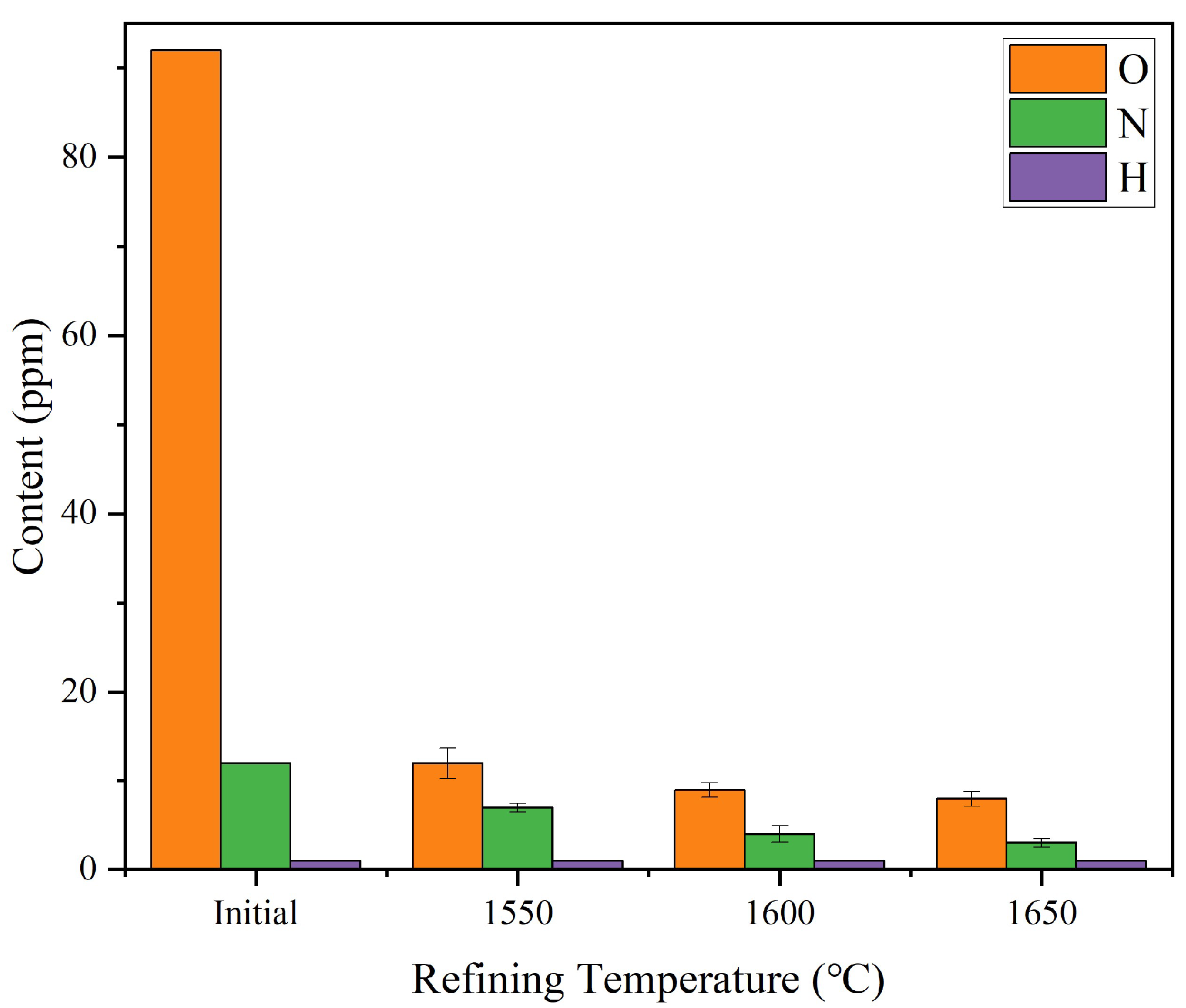

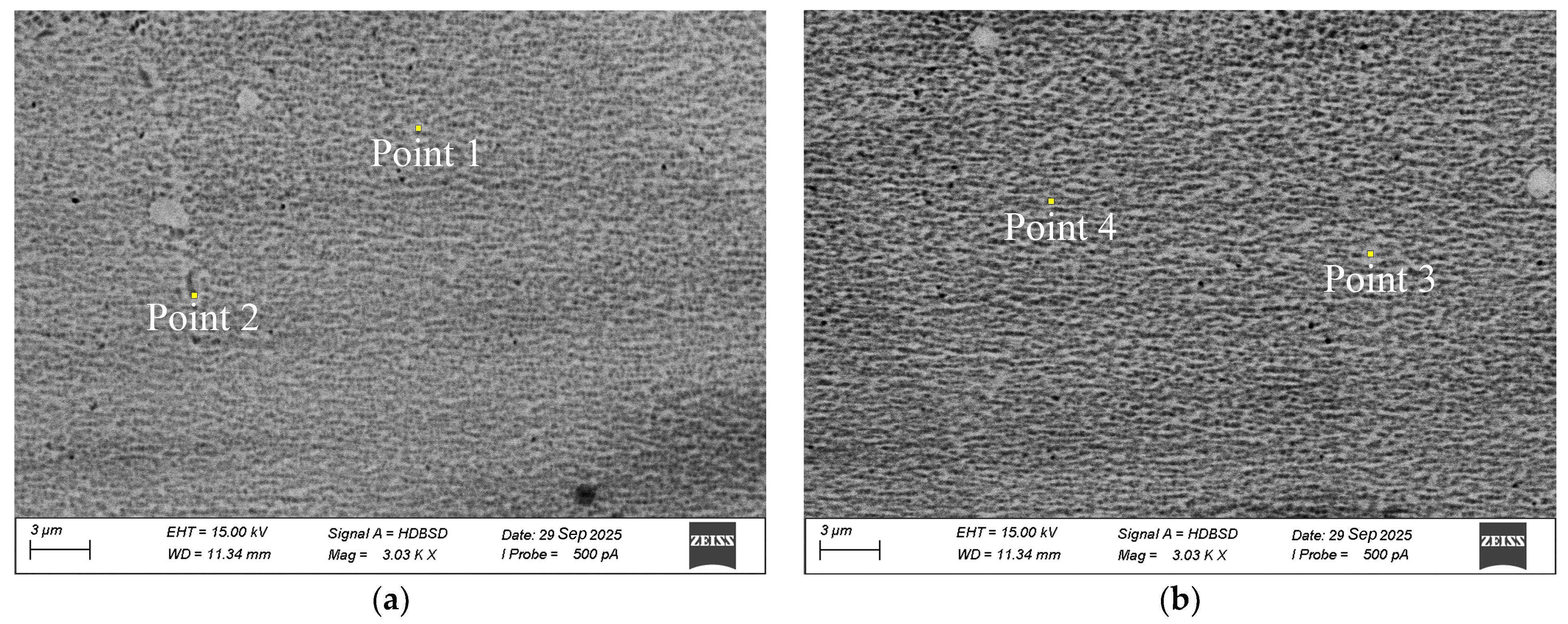
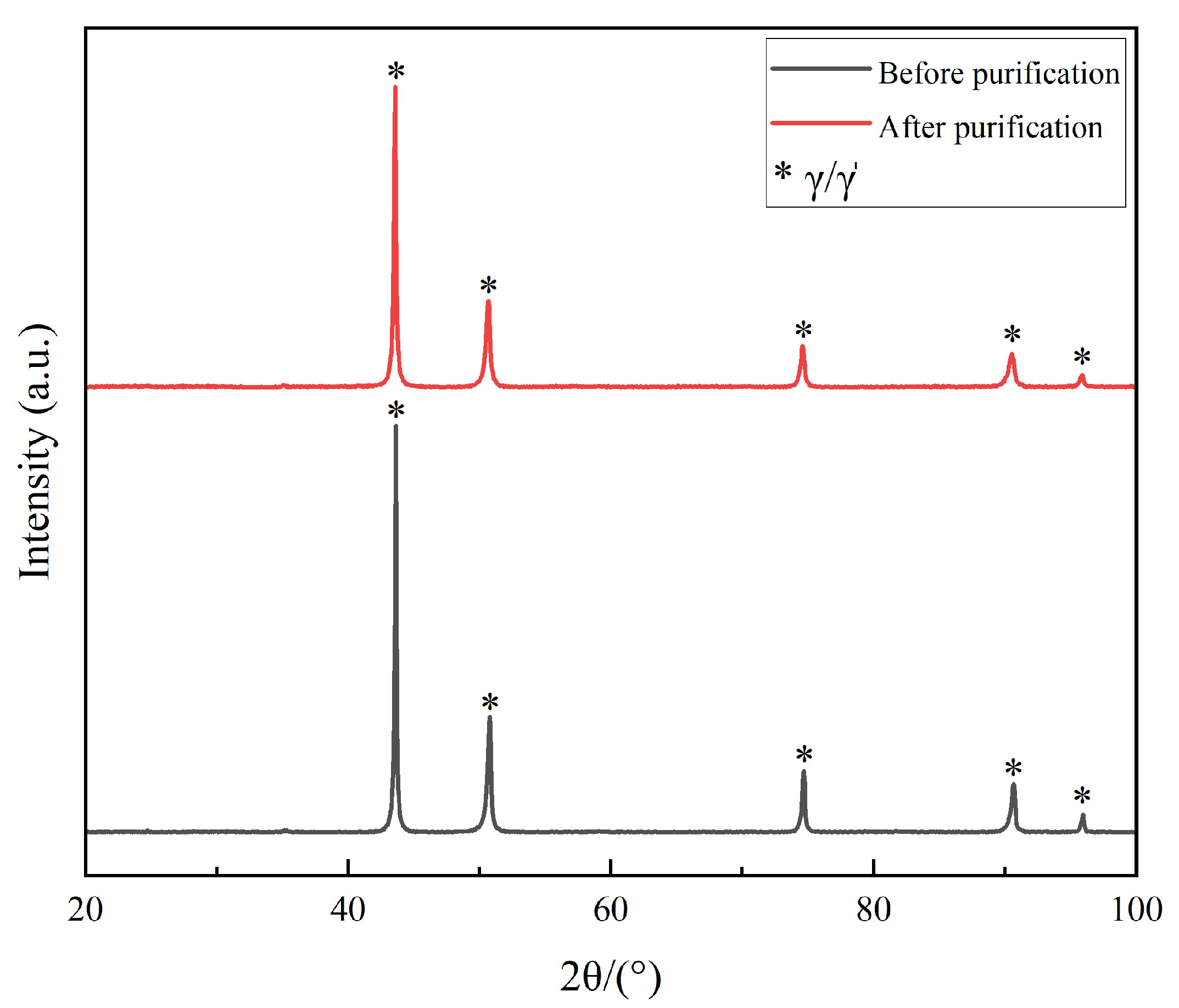
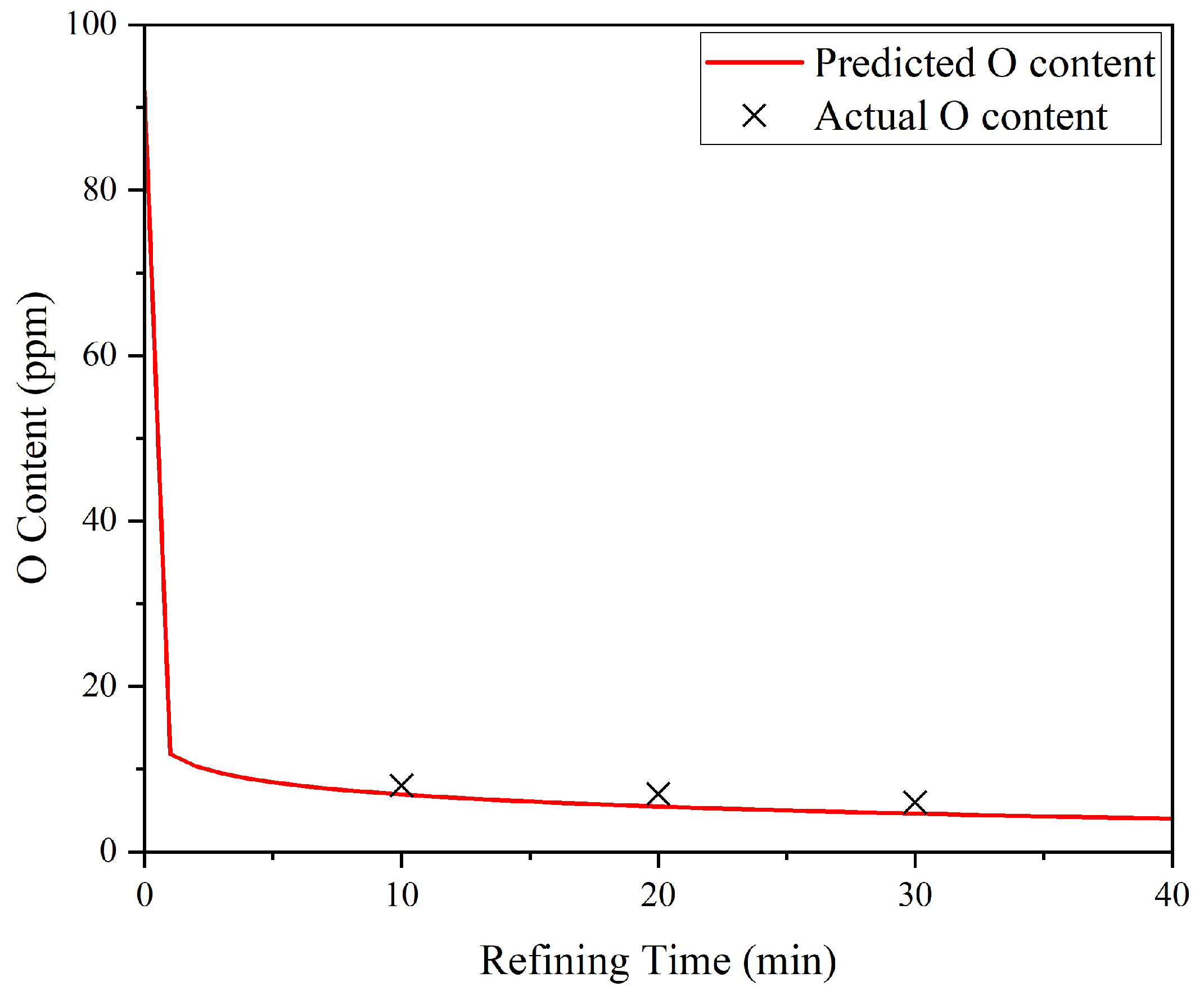
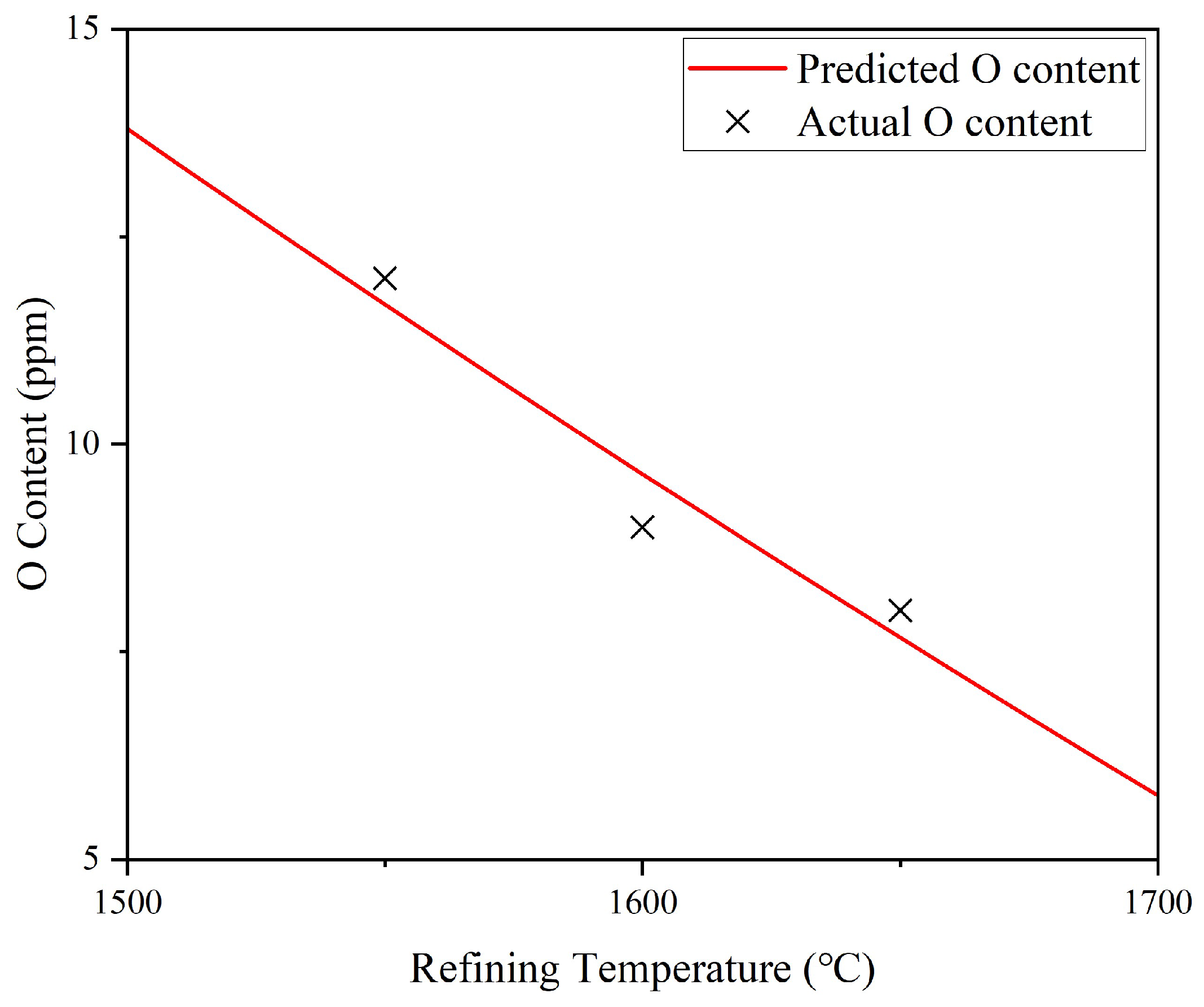
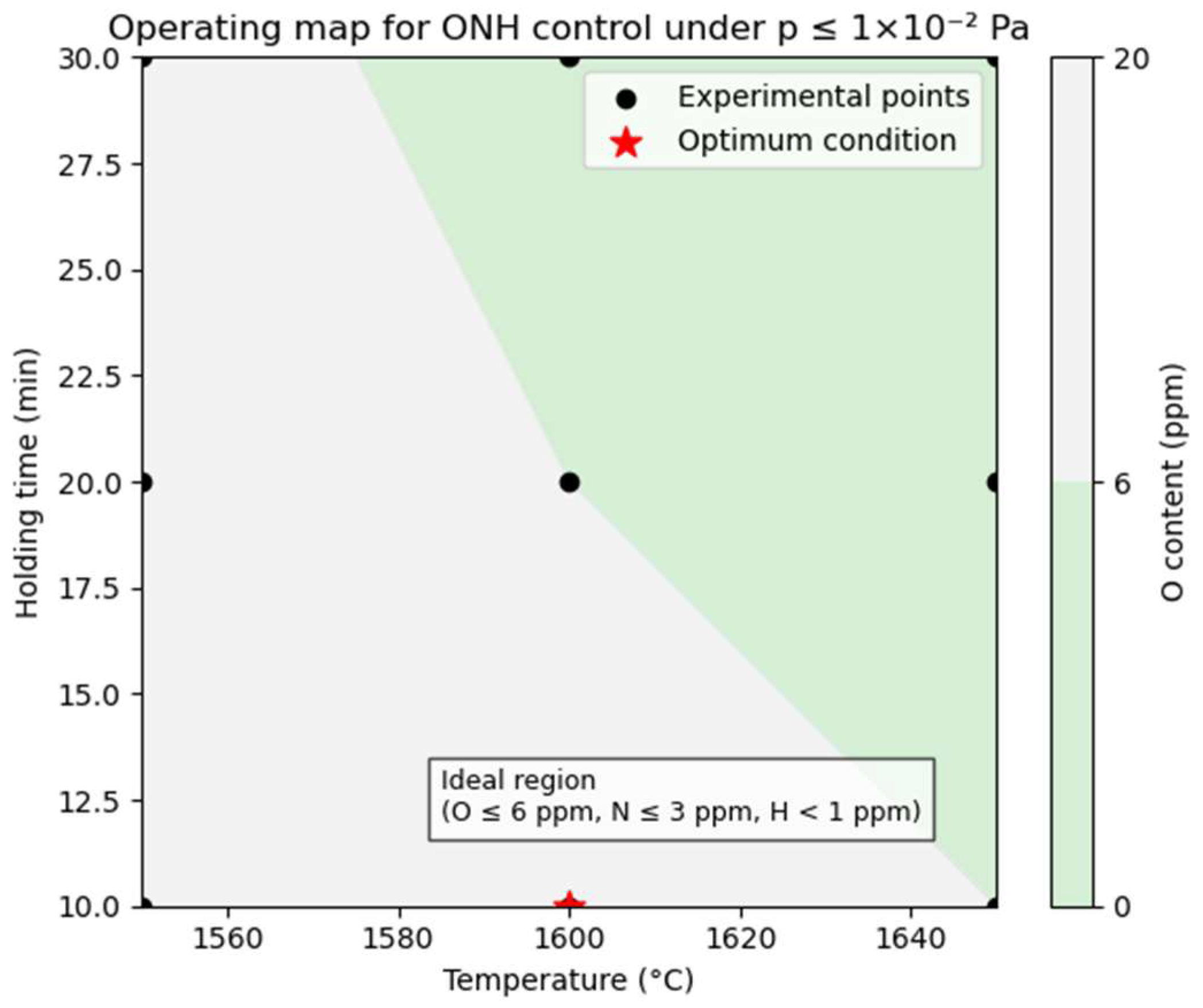
| Cr | Co | Al | Ti | Mo | Nb | W |
| 13.02 | 7.98 | 3.50 | 2.52 | 3.54 | 3.46 | 3.54 |
| Zr | B | C | Ni | O | N | H |
| 0.04 | 0.012 | 0.06 | 62.33 | 0.0092 | 0.0012 | <0.0001 |
| Refining Time (min) | Cr | Co | Al | Ti | Mo | Nb |
| Standard | 12.00–14.00 | 7.00–9.00 | 3.30–3.70 | 2.30–2.70 | 3.30–3.70 | 3.30–3.70 |
| 10 | 12.06 | 8.15 | 3.56 | 2.58 | 3.65 | 3.59 |
| 20 | 11.26 | 8.22 | 3.59 | 2.59 | 3.65 | 3.62 |
| 30 | 11.27 | 8.14 | 3.61 | 2.62 | 3.67 | 3.66 |
| Refining Time (min) | W | Zr | B | C | Ni | |
| Standard | 3.30–3.70 | 0.03–0.07 | 0.006–0.015 | 0.04–0.09 | Bal. | |
| 10 | 3.64 | 0.05 | 0.011 | 0.042 | 62.67 | |
| 20 | 3.62 | 0.05 | 0.012 | 0.051 | 63.34 | |
| 30 | 3.67 | 0.05 | 0.012 | 0.045 | 63.25 | |
| Refining Temperature (min) | Cr | Co | Al | Ti | Mo | Nb |
| Standard | 12.00–14.00 | 7.00–9.00 | 3.30–3.70 | 2.30–2.70 | 3.30–3.70 | 3.30–3.70 |
| 1550 | 12.65 | 8.16 | 3.53 | 2.54 | 3.60 | 3.55 |
| 1600 | 12.78 | 8.18 | 3.52 | 2.54 | 3.61 | 3.54 |
| 1650 | 12.06 | 8.15 | 3.56 | 2.58 | 3.65 | 3.59 |
| Refining Temperature (min) | W | Zr | B | C | Ni | |
| Standard | 3.30–3.70 | 0.03–0.07 | 0.006–0.015 | 0.04–0.09 | Bal. | |
| 1550 | 3.64 | 0.05 | 0.011 | 0.042 | 62.23 | |
| 1600 | 3.60 | 0.05 | 0.012 | 0.047 | 62.12 | |
| 1650 | 3.64 | 0.05 | 0.011 | 0.042 | 62.67 | |
| Point No. | Al (wt.%) | Ti (wt.%) | Cr (wt.%) | Co (wt.%) | Ni (wt.%) | Zr (wt.%) | Nb (wt.%) | Mo (wt.%) | W (wt.%) |
|---|---|---|---|---|---|---|---|---|---|
| 1 | 1.95 | 1.97 | 17.75 | 8.58 | 43.55 | 0.95 | 11.68 | 9.90 | 3.68 |
| 2 | 5.03 | 6.50 | 3.20 | 5.88 | 66.06 | 0.89 | 10.26 | 0.89 | 1.30 |
| 3 | 2.41 | 1.35 | 8.15 | 4.50 | 30.61 | 0.42 | 1.89 | 2.84 | 2.84 |
| 4 | 6.02 | 7.31 | 5.12 | 6.49 | 50.31 | 0.48 | 13.52 | 4.42 | 4.32 |
Disclaimer/Publisher’s Note: The statements, opinions and data contained in all publications are solely those of the individual author(s) and contributor(s) and not of MDPI and/or the editor(s). MDPI and/or the editor(s) disclaim responsibility for any injury to people or property resulting from any ideas, methods, instructions or products referred to in the content. |
© 2025 by the authors. Licensee MDPI, Basel, Switzerland. This article is an open access article distributed under the terms and conditions of the Creative Commons Attribution (CC BY) license (https://creativecommons.org/licenses/by/4.0/).
Share and Cite
Chen, J.; Wang, X.; Zhou, L.; Fu, P.; Cheng, Y.; Zhang, H. Effect of Refining Temperature and Refining Time on Purification and Composition Control of FGH95 Powder Metallurgy Superalloy Return Material During Vacuum Induction Melting. Metals 2025, 15, 1140. https://doi.org/10.3390/met15101140
Chen J, Wang X, Zhou L, Fu P, Cheng Y, Zhang H. Effect of Refining Temperature and Refining Time on Purification and Composition Control of FGH95 Powder Metallurgy Superalloy Return Material During Vacuum Induction Melting. Metals. 2025; 15(10):1140. https://doi.org/10.3390/met15101140
Chicago/Turabian StyleChen, Jiulong, Xuqing Wang, Lei Zhou, Peng Fu, Ying Cheng, and Huarui Zhang. 2025. "Effect of Refining Temperature and Refining Time on Purification and Composition Control of FGH95 Powder Metallurgy Superalloy Return Material During Vacuum Induction Melting" Metals 15, no. 10: 1140. https://doi.org/10.3390/met15101140
APA StyleChen, J., Wang, X., Zhou, L., Fu, P., Cheng, Y., & Zhang, H. (2025). Effect of Refining Temperature and Refining Time on Purification and Composition Control of FGH95 Powder Metallurgy Superalloy Return Material During Vacuum Induction Melting. Metals, 15(10), 1140. https://doi.org/10.3390/met15101140








